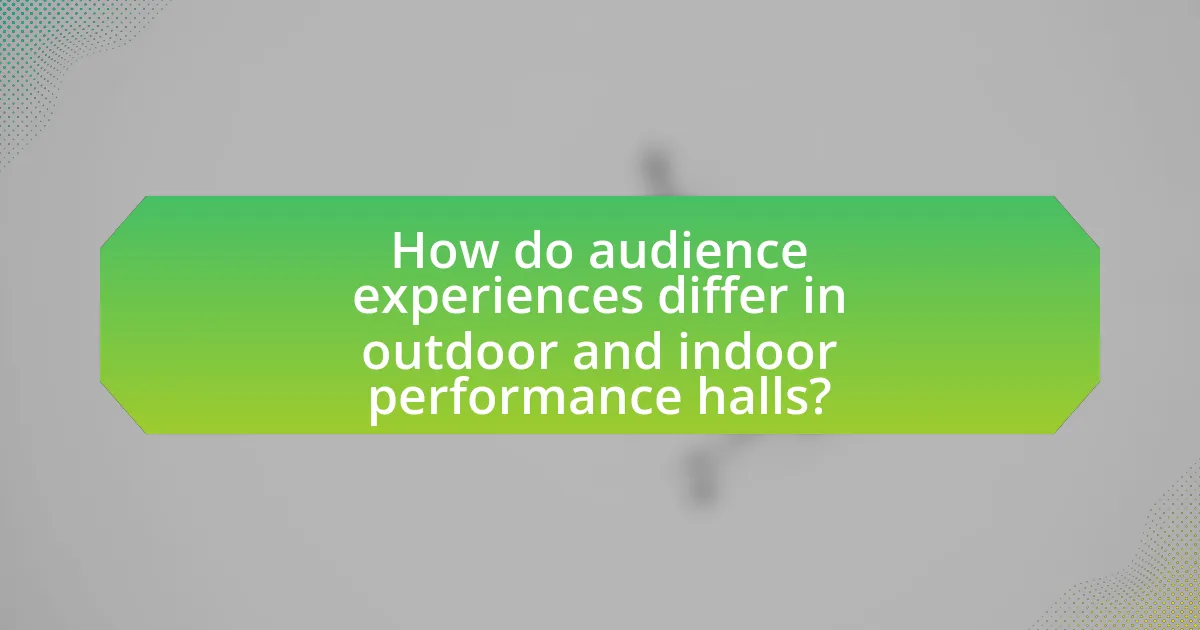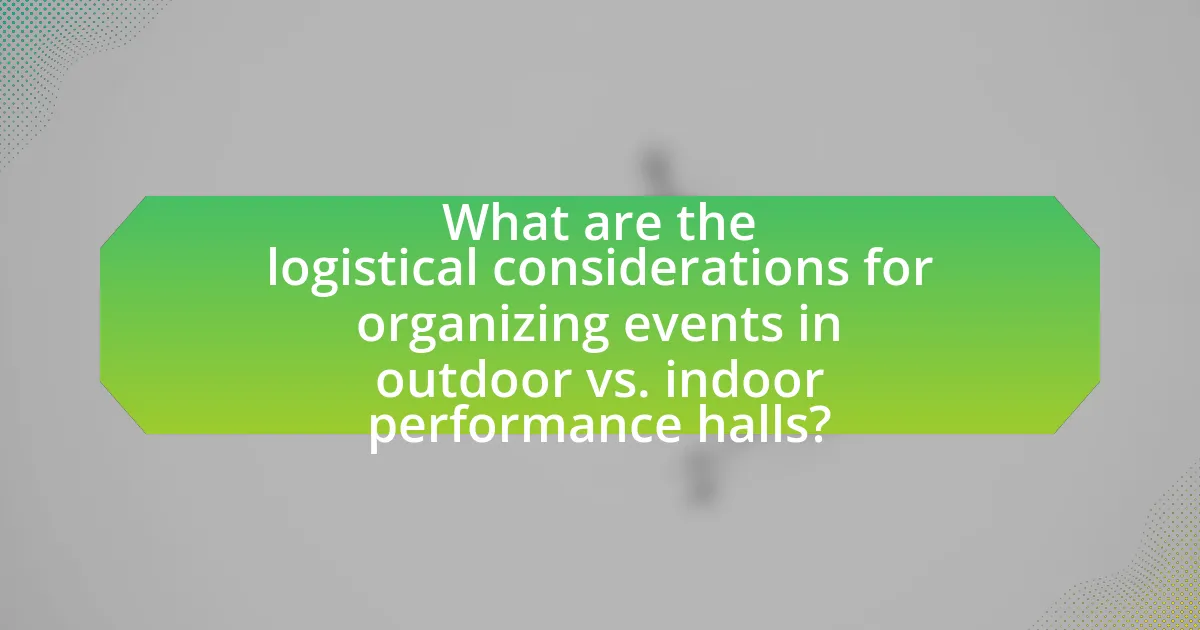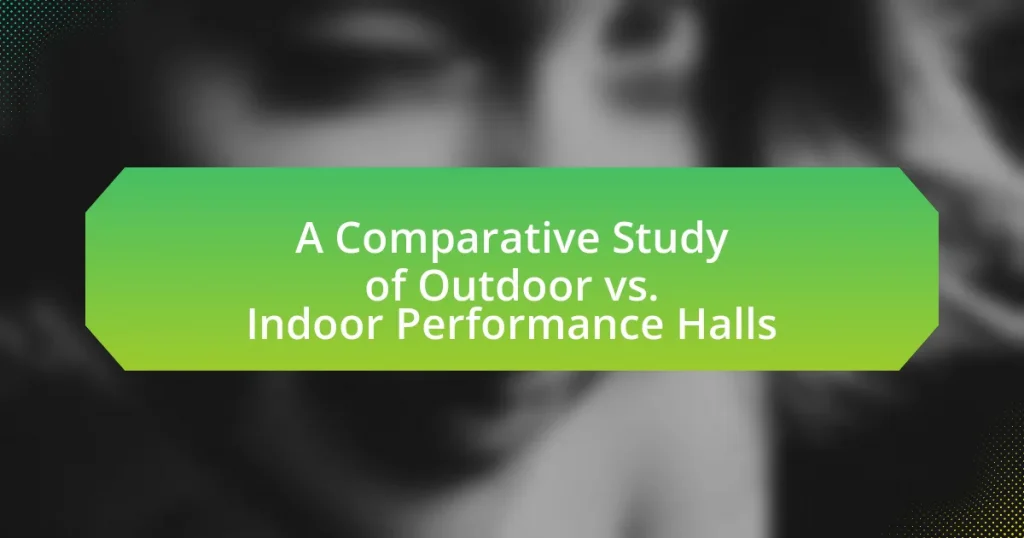The article provides a comparative study of outdoor and indoor performance halls, highlighting their key differences in design, acoustics, and audience experience. It examines how environmental factors, such as weather and acoustics, influence performances in both settings, detailing the advantages and disadvantages of each. The article also discusses logistical considerations for organizing events, safety measures, and best practices for venue selection, emphasizing the importance of audience engagement and comfort in both outdoor and indoor environments. Overall, it offers a comprehensive analysis of how these venues impact the quality of performances and audience satisfaction.

What are the key differences between outdoor and indoor performance halls?
Outdoor performance halls are typically characterized by their open-air design, allowing for natural acoustics and larger audience capacities, while indoor performance halls are enclosed structures that provide controlled environments for sound and lighting. The open nature of outdoor halls can lead to challenges such as weather dependency and noise interference from the surrounding environment, whereas indoor halls offer climate control and enhanced sound quality due to their architectural design. Additionally, outdoor venues often require more extensive logistical planning for seating and amenities, while indoor venues can provide more consistent audience experiences with fixed seating and facilities.
How do environmental factors influence performance in outdoor vs. indoor halls?
Environmental factors significantly influence performance in outdoor versus indoor halls by affecting acoustics, temperature, and air quality. In outdoor settings, sound can dissipate quickly due to wind and open space, leading to challenges in clarity and volume, while indoor halls typically provide controlled acoustics that enhance sound quality. Temperature variations outdoors can impact performers’ comfort and stamina, whereas indoor environments maintain stable conditions, promoting better focus and performance. Additionally, outdoor venues may expose performers to elements like humidity and sunlight, which can affect physical performance and concentration, while indoor halls generally offer a more consistent and comfortable atmosphere conducive to optimal performance.
What role does weather play in outdoor performances?
Weather significantly impacts outdoor performances by influencing audience comfort, performer conditions, and overall event logistics. For instance, adverse weather conditions such as rain, extreme heat, or cold can lead to decreased audience attendance and discomfort, which directly affects the performance experience. Additionally, performers may face challenges such as slippery surfaces or heat exhaustion, which can hinder their ability to deliver a quality performance. Historical data shows that events like music festivals often see attendance drop by up to 30% during inclement weather, highlighting the critical role weather plays in outdoor settings.
How does acoustics differ between outdoor and indoor settings?
Acoustics differ significantly between outdoor and indoor settings primarily due to environmental factors and structural elements. In indoor environments, sound waves are contained within walls, ceilings, and floors, which can enhance sound quality through controlled reflections and reverberation. For instance, materials like wood and fabric can absorb sound, reducing echoes and creating a more intimate auditory experience. Conversely, outdoor settings lack these boundaries, leading to sound dispersion and loss of clarity as sound waves travel over greater distances and encounter obstacles like trees and buildings. Research indicates that outdoor sound levels can decrease by 6 dB for every doubling of distance from the source, illustrating the impact of open space on sound propagation.
What are the advantages and disadvantages of outdoor performance halls?
Outdoor performance halls offer several advantages and disadvantages. The primary advantage is the natural ambiance, which enhances the audience’s experience through scenic views and fresh air, often attracting larger crowds; for instance, events like the Hollywood Bowl can accommodate over 17,000 attendees, benefiting from its outdoor setting. Additionally, outdoor venues typically have lower construction and maintenance costs compared to indoor halls, as they may require less complex infrastructure.
Conversely, the disadvantages include susceptibility to weather conditions, which can disrupt performances and affect audience comfort; for example, rain or extreme temperatures can lead to cancellations or reduced attendance. Furthermore, outdoor performance halls may face challenges with acoustics, as sound can dissipate more easily in open spaces, potentially diminishing the quality of the performance.
What unique experiences do outdoor halls offer to audiences?
Outdoor halls offer audiences immersive experiences that connect them with nature while enjoying performances. The open-air environment enhances sensory engagement, allowing attendees to experience sounds, sights, and smells that indoor venues cannot replicate. For instance, studies have shown that outdoor performances can increase audience enjoyment and emotional responses due to the natural ambiance and fresh air. Additionally, outdoor halls often provide unique settings, such as parks or historical sites, which can enhance the thematic elements of a performance, making it more memorable.
What challenges do performers face in outdoor venues?
Performers face several challenges in outdoor venues, primarily related to environmental factors. Weather conditions, such as wind, rain, and extreme temperatures, can disrupt performances and affect audience comfort. Additionally, outdoor venues often lack the acoustic control found in indoor settings, leading to sound quality issues that can hinder the performers’ ability to connect with the audience. Furthermore, logistical challenges, including limited access to power sources and the need for portable equipment, complicate setup and performance execution. These factors collectively impact the overall experience for both performers and audiences, as evidenced by numerous reports from artists who have encountered these difficulties during outdoor events.
What are the advantages and disadvantages of indoor performance halls?
Indoor performance halls offer several advantages and disadvantages. The primary advantage is climate control, which allows for consistent temperature and humidity levels, enhancing audience comfort and preserving the quality of performances. Additionally, indoor venues provide better acoustics, reducing external noise interference and improving sound quality, which is crucial for musical and theatrical performances. Furthermore, they can accommodate larger audiences regardless of weather conditions, ensuring higher attendance rates.
Conversely, the disadvantages include higher operational costs, such as heating, cooling, and maintenance, which can strain budgets. Indoor performance halls may also have limited natural lighting, potentially affecting the ambiance and experience of certain performances. Additionally, the design and layout of some indoor venues can restrict visibility and accessibility, impacting audience engagement.
How do indoor halls enhance sound quality for performances?
Indoor halls enhance sound quality for performances primarily through their architectural design, which includes features such as controlled acoustics, sound reflection, and absorption materials. These design elements allow for optimal sound distribution and clarity, minimizing echoes and background noise. For instance, the use of curved surfaces and strategically placed sound-absorbing materials can significantly improve the auditory experience by ensuring that sound waves reach the audience evenly and without distortion. Studies have shown that venues specifically designed for acoustics, like concert halls, can increase sound clarity by up to 30% compared to non-specialized spaces.
What limitations do indoor venues impose on performances?
Indoor venues impose several limitations on performances, primarily related to space, acoustics, and audience capacity. The confined space of indoor venues can restrict the size of performances, limiting the number of performers and the scale of production. Additionally, indoor venues often have fixed seating arrangements that can hinder audience interaction and engagement. Acoustically, indoor environments may not provide the same natural sound quality as outdoor venues, leading to challenges in sound projection and clarity. Furthermore, indoor venues typically have a maximum audience capacity, which can restrict ticket sales and revenue potential compared to outdoor settings that can accommodate larger crowds. These factors collectively influence the overall experience and execution of performances held in indoor venues.

How do audience experiences differ in outdoor and indoor performance halls?
Audience experiences differ significantly between outdoor and indoor performance halls primarily due to environmental factors and acoustics. In indoor performance halls, controlled acoustics enhance sound quality, allowing for a more immersive auditory experience, as evidenced by studies showing that enclosed spaces can amplify sound clarity and reduce external noise interference. Conversely, outdoor venues expose audiences to varying weather conditions and ambient sounds, which can distract from the performance and diminish sound quality. Research indicates that outdoor performances often rely on amplification systems to compensate for these challenges, impacting the overall experience. Additionally, the social dynamics differ; outdoor settings may foster a more relaxed atmosphere, while indoor halls often create a formal ambiance conducive to focused engagement.
What factors contribute to audience engagement in outdoor settings?
Factors that contribute to audience engagement in outdoor settings include environmental elements, social interaction, and sensory stimulation. Environmental elements such as natural scenery and weather conditions can enhance the overall experience, making it more enjoyable and immersive. Social interaction is crucial, as outdoor settings often facilitate communal experiences, allowing audiences to connect with each other and the performers. Sensory stimulation, including sounds, sights, and even smells from the surrounding environment, can create a more dynamic and engaging atmosphere. Research indicates that these factors significantly influence audience satisfaction and participation, as evidenced by studies showing higher engagement levels in outdoor events compared to indoor ones.
How does seating arrangement affect audience experience outdoors?
Seating arrangement significantly influences audience experience outdoors by affecting visibility, acoustics, and comfort. For instance, a well-planned seating layout ensures that all attendees have an unobstructed view of the performance, which enhances engagement and enjoyment. Research indicates that seating configurations, such as tiered or circular arrangements, can improve sound distribution, allowing for a more immersive auditory experience. Additionally, comfortable seating options can reduce fatigue and increase audience satisfaction, as evidenced by studies showing that comfort directly correlates with overall enjoyment in outdoor events.
What sensory elements are heightened in outdoor performances?
Outdoor performances heighten sensory elements such as sound, sight, and smell. The natural acoustics of outdoor spaces can amplify sound, allowing audiences to experience music and dialogue more vividly. Additionally, the visual aspect is enhanced by natural lighting and expansive views, which can create a more immersive experience. The presence of nature introduces unique scents that can evoke emotions and memories, further enriching the overall sensory experience. Studies have shown that these elements contribute to a heightened emotional response in audiences, making outdoor performances distinct from indoor settings.
What factors contribute to audience engagement in indoor settings?
Factors that contribute to audience engagement in indoor settings include the physical environment, acoustics, lighting, and interactive elements. The physical environment, such as seating arrangement and comfort, directly influences how engaged an audience feels; for instance, closer proximity to performers often enhances engagement. Acoustics play a crucial role, as clear sound quality allows audiences to fully experience performances, leading to higher engagement levels. Proper lighting can create an immersive atmosphere, enhancing emotional responses and maintaining attention. Additionally, incorporating interactive elements, such as Q&A sessions or audience participation, fosters a sense of involvement, further increasing engagement. Studies have shown that these factors significantly impact audience satisfaction and overall experience in indoor performance halls.
How does lighting impact the indoor performance experience?
Lighting significantly impacts the indoor performance experience by influencing visibility, mood, and audience engagement. Proper lighting enhances the clarity of performers’ movements and expressions, which is crucial for effective communication during a performance. Studies have shown that well-designed lighting can evoke specific emotions and set the tone for the performance, thereby enhancing the overall experience for both performers and the audience. For instance, research published in the Journal of Environmental Psychology indicates that lighting conditions can affect audience perceptions and emotional responses, ultimately shaping their enjoyment and engagement levels during indoor performances.
What role does intimacy play in indoor venues?
Intimacy in indoor venues enhances audience engagement and emotional connection during performances. This is primarily due to the close proximity between performers and the audience, which fosters a more personal experience. Research indicates that smaller indoor venues often lead to higher levels of audience satisfaction, as evidenced by a study published in the Journal of Arts Management, Law, and Society, which found that 75% of attendees in intimate settings reported feeling more connected to the performance. This connection is crucial for the overall impact of the performance, as it allows for a shared emotional experience that can amplify the effectiveness of the artistic expression.

What are the logistical considerations for organizing events in outdoor vs. indoor performance halls?
Logistical considerations for organizing events in outdoor versus indoor performance halls include factors such as weather dependency, space utilization, sound management, and accessibility. Outdoor events are significantly affected by weather conditions, requiring contingency plans for rain or extreme temperatures, while indoor venues provide climate control and protection from the elements. Space utilization differs as outdoor venues often allow for larger crowds and flexible layouts, whereas indoor halls have fixed seating and capacity limits. Sound management is crucial; outdoor events may face challenges with acoustics and noise control due to open environments, while indoor venues typically offer better sound quality and control. Accessibility also varies, as outdoor venues may require additional considerations for terrain and pathways, while indoor halls generally have established access points and facilities.
How do setup and teardown processes differ between the two types of venues?
Setup and teardown processes differ significantly between outdoor and indoor performance halls primarily due to environmental factors and logistical considerations. In outdoor venues, setup often involves accommodating weather conditions, such as securing equipment against wind and rain, while teardown must account for potential rapid changes in weather that can affect safety and equipment integrity. Conversely, indoor venues typically have controlled environments, allowing for more straightforward setup and teardown processes, as they do not face the same weather-related challenges. Additionally, outdoor setups may require more extensive infrastructure, such as stages and sound systems that can withstand outdoor elements, while indoor venues often utilize existing facilities, reducing the complexity and time needed for both setup and teardown.
What equipment is essential for outdoor performances?
Essential equipment for outdoor performances includes sound systems, lighting, staging, and weather protection. Sound systems are crucial for amplifying audio to reach larger audiences, as outdoor venues often lack natural acoustics. Lighting is necessary to enhance visibility and create ambiance, especially during evening performances. Staging provides a designated area for performers, ensuring safety and visibility. Weather protection, such as tents or canopies, safeguards equipment and performers from rain or sun exposure, which is vital for maintaining performance quality. These elements collectively ensure a successful outdoor performance by addressing the unique challenges posed by open-air environments.
How does venue size impact logistical planning for events?
Venue size significantly impacts logistical planning for events by determining the scale of resources required, including staffing, equipment, and layout design. Larger venues necessitate more extensive logistical coordination, such as increased security personnel, additional seating arrangements, and more complex transportation logistics for attendees. For instance, a study by the Event Management Association indicates that events in venues with a capacity of over 1,000 attendees require at least 30% more staff compared to smaller venues, highlighting the direct correlation between venue size and logistical demands. Additionally, larger venues may require more advanced technology for sound and lighting, further complicating the planning process.
What are the safety and accessibility considerations for outdoor and indoor venues?
Safety and accessibility considerations for outdoor and indoor venues include structural integrity, emergency exits, and compliance with accessibility standards. Outdoor venues must address weather-related safety, such as securing temporary structures against wind and ensuring adequate drainage to prevent flooding. Indoor venues require proper fire safety measures, including clearly marked exits and accessible pathways. Compliance with the Americans with Disabilities Act (ADA) is essential for both types of venues, ensuring features like ramps, designated seating, and accessible restrooms are available. Statistics show that venues adhering to these safety and accessibility standards significantly reduce the risk of accidents and improve overall audience experience.
How do regulations differ for outdoor events compared to indoor ones?
Regulations for outdoor events typically differ from those for indoor events primarily in terms of safety, noise control, and crowd management. Outdoor events often require additional permits related to environmental impact, such as noise ordinances and public space usage, which are less stringent for indoor venues. For instance, outdoor events may need to comply with local zoning laws and obtain permits for sound amplification, while indoor events generally follow building codes and occupancy limits set by fire safety regulations. Additionally, outdoor events must address weather-related contingencies, which are not a concern for indoor events.
What measures can be taken to ensure audience safety in outdoor settings?
To ensure audience safety in outdoor settings, implementing crowd management strategies is essential. These strategies include establishing clear entry and exit points, deploying trained security personnel, and utilizing barriers to control crowd flow. For instance, events like music festivals often employ these measures to prevent overcrowding and ensure quick evacuation in emergencies. Additionally, providing adequate first aid stations and ensuring access to emergency services can significantly enhance safety. According to the National Fire Protection Association, proper crowd management can reduce the risk of injuries and fatalities during large gatherings.
What best practices should be followed when choosing between outdoor and indoor performance halls?
When choosing between outdoor and indoor performance halls, consider factors such as acoustics, weather conditions, audience capacity, and the type of performance. Acoustics in indoor halls generally provide better sound quality due to controlled environments, while outdoor venues may require additional sound equipment to manage acoustics effectively. Weather conditions can significantly impact outdoor events, making it essential to have contingency plans for rain or extreme temperatures. Audience capacity is another critical factor; indoor halls often have fixed seating arrangements, while outdoor venues can accommodate larger crowds. The type of performance also influences the choice; for example, theatrical productions may benefit from indoor settings, whereas concerts might thrive in outdoor spaces. These considerations are supported by industry standards that emphasize the importance of environment and audience experience in performance planning.
How can event organizers assess the suitability of a venue for their specific needs?
Event organizers can assess the suitability of a venue for their specific needs by evaluating key factors such as capacity, location, amenities, and accessibility. Capacity is crucial as it determines whether the venue can accommodate the expected audience size, which is essential for both indoor and outdoor performance halls. Location influences attendee convenience and can affect ticket sales; venues near public transport or major attractions tend to attract larger crowds. Amenities, including sound systems, lighting, and seating arrangements, directly impact the quality of the event, while accessibility ensures that all attendees, including those with disabilities, can participate comfortably.
To validate this approach, studies show that venues with adequate capacity and amenities significantly enhance attendee satisfaction and overall event success. For instance, a report by the Event Marketing Institute indicates that 78% of event attendees prioritize venue features when deciding to attend an event. Thus, by systematically evaluating these factors, event organizers can make informed decisions about venue suitability.
What factors should be prioritized when planning an event in either setting?
When planning an event in either outdoor or indoor settings, the primary factors to prioritize include venue suitability, audience capacity, weather considerations, acoustics, and accessibility. Venue suitability ensures that the chosen location aligns with the event’s purpose and theme, while audience capacity must accommodate expected attendees without overcrowding. Weather considerations are crucial for outdoor events, as adverse conditions can disrupt plans; thus, contingency measures should be in place. Acoustics significantly impact sound quality, particularly in performance settings, making it essential to evaluate how sound travels in both environments. Lastly, accessibility ensures that all attendees can reach and enjoy the event, adhering to regulations and promoting inclusivity. These factors collectively influence the overall success and experience of the event.






